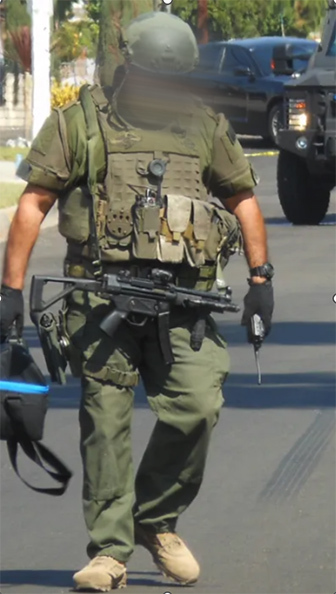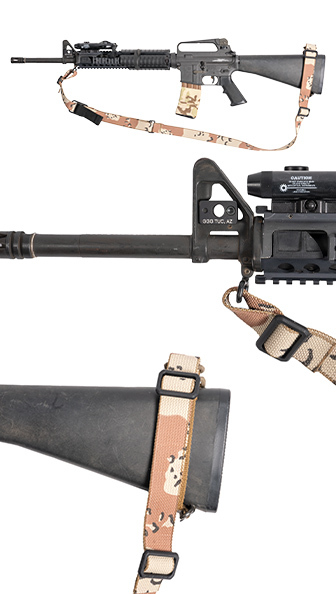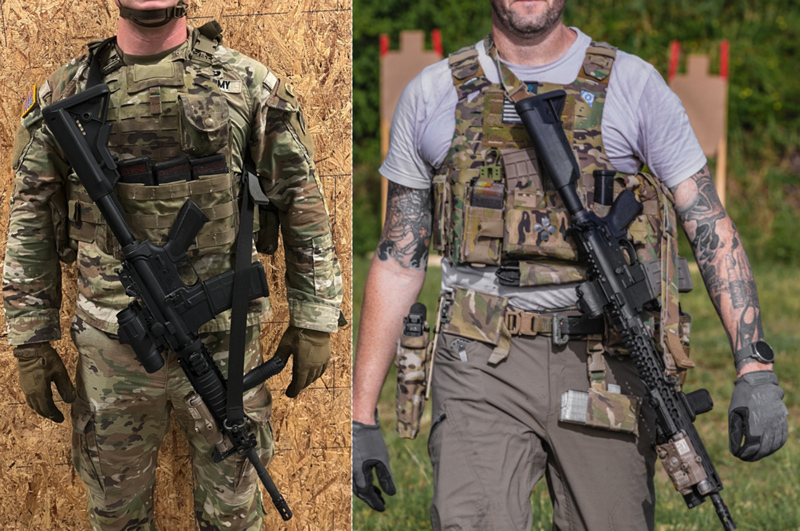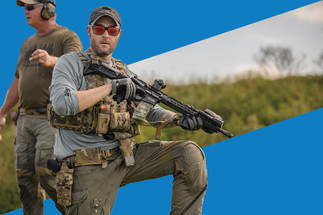Feb 24th 2025
Safe Rifle Carry
Rifle Sling Placement
Always Better® | May 22nd, 2025
Taking notes, or pretending to take notes, during your leader’s truck side mission brief… punching info into your tactical cell phone either for actual job related duties or updating your Insta in between firing relays at your favorite instructor’s class… walking across the parking lot to talk to someone, post incident… helping move casualties… transitioning to pistol… digging around in your pouches for that fresh battery, weapons tool, licky, chewy, or can of dip (for those man enough to actually pinch real tobacco and not those unholy nicotine packets), or conducting the ritual of actually putting said dip in your mouth… all of these things can and happen with regularity, whilst having a hot rifle attached to your person. Hot, Red Status, Condition One, Loaded, Locked and Loaded; whatever term your tribe employs to mean a rifle that can be fired literally with the flick of a switch and the movement of the trigger is the status we’re talking about.
Contrary to some people’s belief, the rules of firearm safety are still present, valid, and must be paid their due when we have loaded rifles attached to our fronts or backs. That flick of the switch and movement of a trigger I mentioned above? Yeah, those actions can, and have many times, happened while no human hands were on the rifle. And where was the barrel pointing at that time?
One of the four performance points of a “duty sling” (that phraseology will be covered in a future article) is that it, and I am NOT paraphrasing here: provide a reliable and repeatable front sling position in accordance with the rules of firearms safety when my hands are off the gun. So how do we solve for this particular “X” of a variable ? I submit it’s a 50/50 split between equipment and use technique. The first half of the equation would be your rifle’s sling.

Not cool bro, NOT cool. The SMG doesn’t negate the rules of firearm safety when your hands are off the gun… thus the need for a “reliable and repeatable position in accordance with the rules of firearms safety when your hands are off the gun.” A properly slung rifle (again, a 50/50 split between the right sized sling and implementing it correctly) will allow movement even with your hands off the firearm.

Where and how we mount it on the rifle is the first step to success on multiple fronts. I will die on this hill: for broadest capability and to get the most out of a 2-point adjustable sling one must mount it all the way on the end of the buttstock and approximately 10 - 12 inches to the front of the magazine well on an AR platform rifle. Any set up that is not as described has the potential to create issues and be less capable for all sorts of geometry and “gravitic” reasons.
So that’s the equipment part. The usage technique is what can be done with a loaded rifle once we decide to take both our hands off it. One option is to just let it do what it does and let go of it. This technique used to serve us well. “Us” being those old enough to have used naked ARs by modern standards that had no lights, lasers, fore grips, or hot suppressors. Once those things moved from the category of “only the cool guys with specific needs have those things” to “every AR needs those things” that technique started to present some problems. The fix? Flip the rifle over and voila! No more catching a hot suppressor to your leg, or a foregrip to the family jewels. Notice how the sling will run over the top of the magazine and sorta trap it to your body ? It also has the side benefit of having the ability to walk without the rifle constantly bouncing with every step you take, which makes the outcomes better when shooting a pistol. So again, all sorts of benefits across a spectrum of potential use cases.

I call this position “Front Sling.” It’s simple and descriptive and rolls off the tongue better than “Chris’s Inverted Rifle Admin Position One (of Three).”
Front sling does a lot for us, and in a lot of different contexts. Everything from standing behind the line at your favorite instructor’s class, to transitioning to pistol while on the move (and delivering multiple/rapid precision shots with it). The equipment needs to be right, and the technique needs to be congruent with our intended outcomes.
P.S. Don’t use single point slings. They do not have any of the traits described above. When you’re hands off the gun with a single point, that gun is quite literally a free agent. No bueno, along with a whole host of issues when viewed from the “duty” paradigm. But again, that’s an essay for another day.
Watch Chris Sizelove Talk: Setup and Size Guide for the M4 Sling Kit
About Chris Sizelove
Chris Sizelove is a retired Master Sergeant who had a distinguished career in the U.S. Army. Joining in 1999, he served in various capacities in the elite 75th Ranger Regiment spanning across the 2nd, 3rd, and 1st Battalions. His extensive service includes roles as a Pre-Ranger Instructor and a pivotal participant in forming the Regimental Special Troops Battalion (RSTB). Sizelove also held the elite position of Master Breacher of the Regiment and later transitioned to roles in the Defense Intelligence Agency.
About Blue Force Gear®
BFG, headquartered in Pooler, Georgia, has been a trusted name in professional-grade gear and accessories for two decades. Their commitment to excellence, innovative designs, and use of premium materials have made them a favorite among military, law enforcement, and recreational shooters worldwide.
Press Contact
PR Contact: Marketing@blueforcegear.com
Sales and Dealer Contact: Sales@blueforcegear.com

